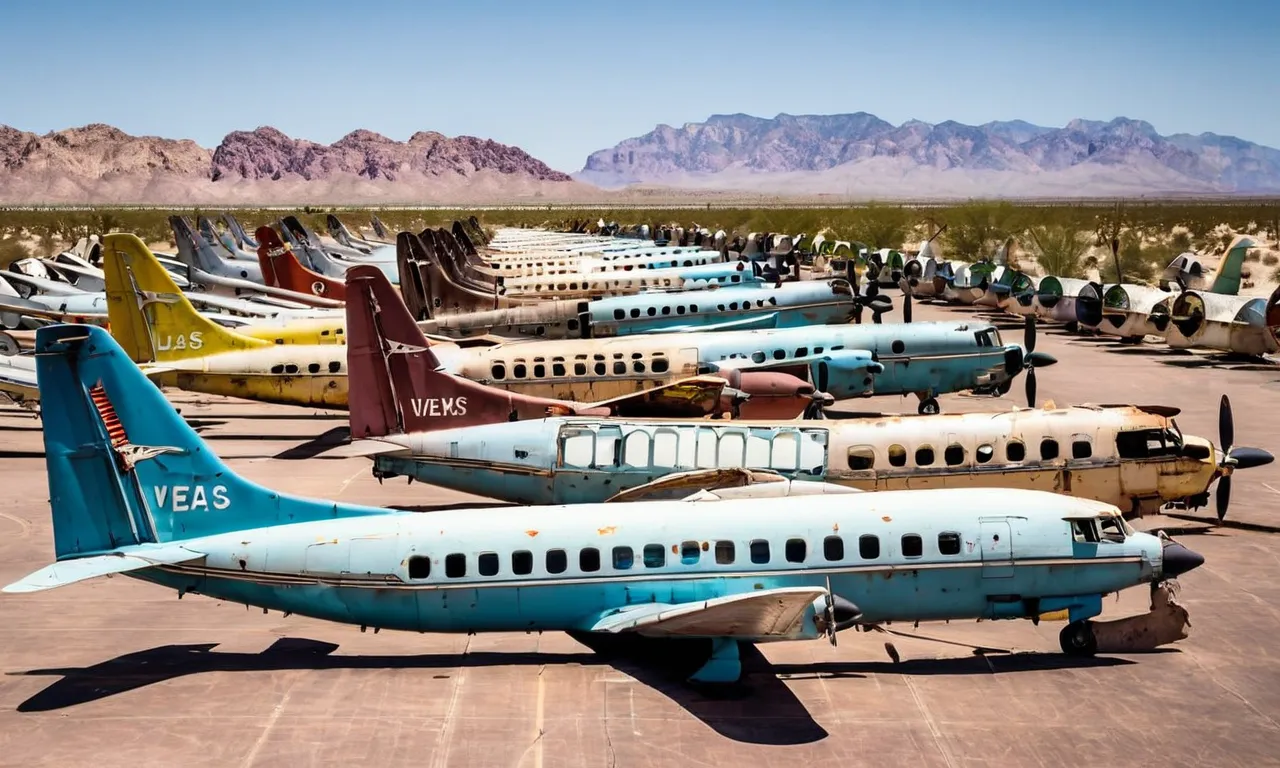Inside The Airplane Graveyards Of Las Vegas
Las Vegas may be famous for its glitzy casinos and lively nightlife, but just outside the city lie massive airplane graveyards full of retired commercial jets. If you’ve ever wondered what happens to planes after they’re taken out of service, these eerie resting places provide the answer.
A Brief History of Airplane Graveyards
When we think of Las Vegas, images of glittering casinos, luxurious hotels, and vibrant nightlife often come to mind. However, hidden away from the bustling Strip, there lies a fascinating and lesser-known world – the airplane graveyards.
These sprawling sites serve as the final resting place for retired aircraft, offering a unique glimpse into the aviation industry’s past. Let’s delve into the history of these airplane graveyards and uncover their origins and expansion in the Mojave Desert.
Origins After WWII
The story of airplane graveyards can be traced back to the aftermath of World War II. As the war came to an end, the demand for military aircraft significantly decreased. The United States, being one of the major players in the war, had an extensive inventory of surplus planes that were no longer needed.
These surplus aircraft had to be stored somewhere, and thus, the concept of airplane graveyards was born.
One of the earliest and most well-known airplane graveyards in Las Vegas is the “Boneyard” at Nellis Air Force Base. This site served as a storage and preservation facility for retired military aircraft.
The dry climate of the Mojave Desert was ideal for preventing corrosion and preserving the aircraft’s structural integrity. Over the years, this graveyard became a haven for aviation enthusiasts, historians, and photographers, who marveled at the sight of rows upon rows of retired warplanes.
Expansion in the Mojave Desert
As the aviation industry continued to evolve, the need for airplane graveyards expanded beyond military aircraft. With the rise of commercial aviation, airlines faced the challenge of retiring older planes and finding a suitable place to store them.
The vast expanse of the Mojave Desert in Nevada provided the perfect solution.
Today, the Mojave Desert is home to several airplane graveyards, including the Southern California Logistics Airport in Victorville and the Mojave Air and Space Port. These sites house decommissioned commercial aircraft from various airlines around the world.
From jumbo jets to smaller regional planes, these graveyards are a testament to the ever-changing nature of the aviation industry.
Visiting these airplane graveyards can be a surreal experience. As you walk among the rows of retired aircraft, you can’t help but feel a sense of awe and wonder. Each plane has its own unique story, representing a bygone era of aviation.
Some have been repurposed for spare parts, while others await their fate as a museum exhibit or potential restoration project.
If you’re interested in learning more about the fascinating world of airplane graveyards, websites like airplaneboneyards.com provide detailed information, photographs, and even guided tours of these extraordinary sites.
So the next time you find yourself in Las Vegas, take a break from the glitz and glamour and venture into the Mojave Desert to explore the hidden treasures of the airplane graveyards. You’ll be amazed at the rich history and stories that lie within these vast aircraft graveyards.
Commercial Planes in the Las Vegas Graveyards
Boeing 747 Jumbo Jets
Las Vegas is home to several airplane graveyards where commercial planes find their final resting place. Among the various models of planes, the Boeing 747 Jumbo Jets hold a prominent presence in these graveyards.
These massive aircraft, once the epitome of luxury and long-haul travel, now sit idle, waiting to be repurposed or dismantled. With their iconic hump and four engines, these planes were once a symbol of the golden age of aviation.
However, as newer and more efficient aircraft entered the market, the demand for these giants dwindled, leading them to end up in the Las Vegas graveyards.
Boeing 737s
Another common sight in the airplane graveyards of Las Vegas is the Boeing 737. This popular narrow-body aircraft, known for its reliability and efficiency, has been a workhorse for many airlines around the world.
However, as airlines upgrade their fleets with newer models, the older 737s are retired and find their way to these graveyards. Despite their retirement, these planes have a rich history and have transported millions of passengers over the years.
Boeing 757s
The Boeing 757, a mid-size, narrow-body twinjet, is also well-represented in the Las Vegas airplane graveyards. This versatile aircraft was designed for both short and medium-range flights, making it a popular choice for many airlines.
However, with advancements in technology and the introduction of more fuel-efficient models, the demand for the 757 declined. As a result, many of these planes are now parked in the graveyards of Las Vegas, awaiting their fate.
Boeing 767s
The Boeing 767, a wide-body twinjet, is yet another model that can be found in the airplane graveyards of Las Vegas. This aircraft revolutionized long-haul travel with its range and passenger capacity.
However, with the introduction of newer wide-body aircraft, such as the Boeing 787 Dreamliner, the demand for the 767 decreased. As a result, many of these planes have been retired and are now stored in the Las Vegas graveyards.
Airbus A320 Family Jets
While the majority of planes in the Las Vegas graveyards are Boeing models, there are also a few Airbus A320 family jets amongst them. The A320 family, which includes the A319, A320, and A321, is a popular choice for many airlines due to its efficiency and range.
However, as airlines upgrade their fleets with newer Airbus models like the A320neo, the older A320 family jets are retired and end up in the airplane graveyards of Las Vegas.
Notable Tenants at the Las Vegas Airplane Boneyards
Jets from Major US Airlines
Las Vegas is home to several airplane boneyards where retired aircraft are stored. These boneyards, also known as aircraft graveyards, are fascinating places filled with planes that once soared through the skies with major US airlines.
Some of the notable tenants at these boneyards include jets from American Airlines, Delta Air Lines, and United Airlines.
American Airlines, one of the largest airlines in the world, has a significant presence in the Las Vegas boneyards. Here, you can find retired aircraft from the American Airlines fleet, ranging from smaller regional jets to larger wide-body planes.
These planes have served millions of passengers and traveled countless miles before being retired.
Delta Air Lines, another major player in the aviation industry, also has a presence in the Las Vegas airplane boneyards. The boneyards house retired Delta jets that once flew across the United States and around the world.
These planes have witnessed the evolution of air travel and have played a crucial role in connecting people from different parts of the globe.
United Airlines, one of the oldest and largest airlines in the United States, is another notable tenant at the Las Vegas airplane boneyards. The boneyards are home to a variety of retired United jets, including iconic aircraft models that have become synonymous with the airline’s brand.
These planes have transported passengers to destinations near and far, leaving a lasting impact on the history of aviation.
International Retirees
In addition to jets from major US airlines, the Las Vegas airplane boneyards also house retired aircraft from international carriers. These international retirees add a diverse flavor to the already impressive collection of planes found in the boneyards.
Airlines from all over the world have chosen the Las Vegas boneyards as the final resting place for their retired aircraft. From European carriers like British Airways and Lufthansa to Asian airlines like Singapore Airlines and Cathay Pacific, the boneyards provide a home for planes that have traversed the globe.
These international retirees offer a unique glimpse into the global aviation industry. Each plane has its own story to tell, representing a different airline, a different culture, and a different era of air travel.
Exploring the Las Vegas airplane boneyards gives aviation enthusiasts the opportunity to discover and appreciate the rich history of international airlines.
For more information on the Las Vegas airplane boneyards and the notable tenants they house, you can visit lasvegasboneyards.com. This website provides detailed insights into the various aircraft models and airlines that can be found in these intriguing graveyards of the sky.
Salvaging Parts and Recycling Retired Planes
When it comes to retired airplanes, Las Vegas is home to an intriguing and unconventional destination – the airplane graveyards. These vast expanses of land are where planes that have reached the end of their operational life are parked, awaiting their fate.
However, it’s not all doom and gloom for these retired giants of the sky. In fact, they become a treasure trove for salvaging valuable parts and recycling materials.
Interior Parts and Engines
Once a plane is retired and reaches the airplane graveyard, salvage crews get to work carefully extracting and cataloging valuable interior parts and engines. These components are in high demand by airlines and maintenance companies seeking to refurbish or replace worn-out parts on their active aircraft.
From seats and galleys to lavatories and avionics systems, these airplane graveyards hold an inventory of parts that can be reused, saving airlines significant costs. Engines, in particular, fetch a premium due to their complexity and high market value.
Salvaging these parts from retired planes not only helps keep active aircraft in operation but also reduces the need for manufacturing new parts, which can have a positive environmental impact. Additionally, recycling these components decreases the amount of waste that ends up in landfills, making it a win-win situation for both the aviation industry and the planet.
Recycling Aluminum and Other Metals
One of the most valuable materials found in retired planes is aluminum. The vast majority of aircraft are made from this lightweight and durable metal, making it a highly sought-after resource. In the airplane graveyards of Las Vegas, aluminum is carefully extracted from the retired planes and sent to recycling facilities.
Recycled aluminum can be used in a variety of industries, including automotive, construction, and packaging. It takes significantly less energy to produce aluminum from recycled sources compared to mining and refining new aluminum ore.
This not only conserves natural resources but also reduces greenhouse gas emissions.
In addition to aluminum, other metals such as steel, titanium, and copper are also salvaged from retired planes. These metals can be recycled and used in various applications, contributing to a more sustainable and circular economy.
Are Airplane Graveyards Open to Visitors?
Many people are fascinated by airplanes and the aviation industry, and the thought of visiting an airplane graveyard can be intriguing. Airplane graveyards, also known as aircraft boneyards or aircraft storage facilities, are where retired or decommissioned aircraft are stored.
These facilities serve as temporary or permanent resting places for planes that are no longer in use.
So, are airplane graveyards open to visitors?
The answer to this question depends on the specific graveyard and its policies. Some airplane graveyards allow public tours, while others do not permit visitors at all. Those that do offer tours often have certain rules and regulations in place to ensure the safety of visitors and the preservation of the aircraft.
Tours of Airplane Graveyards
Some airplane graveyards have recognized the public’s interest in their facilities and have started offering guided tours. These tours provide a unique opportunity for aviation enthusiasts, photographers, and curious travelers to get an up-close look at the retired aircraft.
During these tours, visitors are typically taken on a guided bus or walking tour around the facility. Knowledgeable guides provide information about the history of the aircraft, the graveyard’s operations, and the different types of planes stored there.
Visitors may even have the chance to explore the interiors of certain aircraft.
It’s important to note that these tours often require advance booking and may have restrictions on photography or touching the aircraft. Additionally, some airplane graveyards only offer tours to organized groups or aviation professionals, rather than individual visitors.
Famous Airplane Graveyards
There are several well-known airplane graveyards around the world, with one of the most popular being located in the Mojave Desert near Las Vegas, Nevada. The Mojave Air and Space Port is home to numerous retired commercial and military aircraft, including iconic planes like the Boeing 747.
In addition to the Mojave Air and Space Port, other famous airplane graveyards include the Davis-Monthan Air Force Base in Arizona, where the United States Air Force stores and preserves retired military aircraft, and Alice Springs in Australia, which serves as a storage facility for airlines from around the world.
If you’re interested in visiting an airplane graveyard, it’s best to check the specific graveyard’s website or contact them directly to inquire about their visitor policies and any available tours. Keep in mind that access to these facilities may be limited and subject to change due to security or other operational reasons.
So, while airplane graveyards may not always be open to visitors, some do offer tours and provide a fascinating glimpse into the world of aviation history and retired aircraft.
Conclusion
So while most tourists flock to The Strip when visiting Las Vegas, venture just outside city limits and you’ll find a resting place for aviation history. Hundreds of retired passenger jets sit in the dry desert heat, either awaiting their fate in the scrap pile or luckily finding an extended life through parted out spare components.








